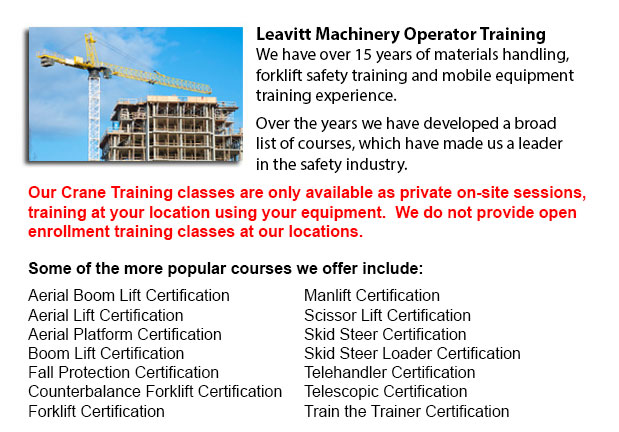
Overhead Crane Safety Training Penticton - The overhead crane safety training course is meant to equip the operators with the right skills and knowledge in the areas of: crane safety precautions, materials handling, accident avoidance, and equipment and stock protection. Each of the trainees will get to learn about numerous kinds of overhead cranes, their capabilities and their uses in various environments. For operators who are trained and licensed, the shift in liability moves from the company to the operator. Hence, the program emphasizes individual operator tasks.
The operators in the overhead safety training course will be given instruction on the proper methods for doing checks: the pre-shift inspection and the more detailed in-depth inspection. These are important every day routines that should be logged. Properly recorded pre-shift inspections help to protect the company from liability in the event of an accident. Pre-shift checks also prevent damage, expensive repairs and accidents. Operators learn how to designate a specific person to handle checks, how to report problems, and how to maintain the log book.
Every check must be documented and carried out regularly. Things that should be checked for possible concerns, comprise: increase in the throat opening, hooks for cracks, hoist ropes for corrosion, degree of twist, loss of diameter, worn wires, bird caging and kinks, broken wires, heat and chemical damage; chains for gouges and nicks, twists, corrosion and cracks, excessive wear, distortion, stretching, pits, damage caused by extreme heat.
The operator will get to learn the right techniques about right rigging measures. The process of rigging involves the understanding of the manufacturer's data plate, determining the weight of materials to be lifted, selecting the gear, and using safe practices to secure the load. The course include in detail the following: safe working loads, and the capacities of ropes, chains, hooks, shackles and slings.
It is essential to know who can use the cranes at your facility, physical requirements of the job, and operator credentials needed for specialized tasks and permits. Safety is a priority when using in the vicinity of pedestrian traffic.
The duties involved in the safe crane use consists of checking for hydraulic leaks, undertaking visual inspections, testing the controls, checking the safety guards, examining the hoist rope and hook, limit switches and braking mechanisms. Correct reporting procedures are vital. These topics are all included in depth in the course.
Correct moving and lifting procedures with cranes and hoists are covered in the program. Operators will become knowledgeable in hand signals. Training involves how to attach the load, raise the load, abort a lift, set the load and unhook the slings.
The steps included with moving the load, consists of: stopping and starting procedures, controlling and guiding the load, observing working conditions and working with signals. In the event of power failures, the operator will need to know how to proceed. The course covers techniques for removing the slings and lowering the load, storage of equipment, parking the crane, and securing an indoor and outdoor crane.
-
Forklift Certification Schools Penticton
Forklift Certification Schools Penticton - In North America, forklift certification is mandatory, making forklift training programs essential for both the business and their employees working as operators of forklifts. Forklift training focuses on sa... More -
Telehandler Training Courses Penticton
Telehandler Training Courses Penticton - The employer has the responsibility to make sure that their personnel are trained to work proficiently utilizing telehandler machinery. The workers have to be assessed for their ability to utilize the machine.... More -
Certified Fall Protection Training in Penticton
There are many injuries at work linked to falling and lots of fall-related deaths reported each and every year. Most of these instances might have been prevented with better training, better precautions in place, and by properly equipping employees b... More -
Zoom Boom Training Penticton
Zoom Boom Training Penticton - Zoom Boom Training is designed to train operators on variable reach forklifts. The objectives of the training are to impart an understanding of the physics of the machine, and to outline the operator's job. This course... More -
Crane Training Schools Penticton
Crane Training Schools Penticton - We have designed various Mobile Crane Operation programs at our Crane Training Schools. These programs are recommended for the experienced operator who needs re-certification or certification, and for inexperienced... More -
Aerial Lift, Boom Lift, Man Lift, Scissor Lift Training in Penticton
Lift tables or also referred to as scissor hoists can lift up both individuals and materials vertically. They are normally utilized in industrial, construction and commercial environments. Normally, the use of a scissor forklift is to lift and lower... More -
Forklift Training Program Penticton
Forklift Training Program Penticton - The forklift is a common powered industrial vehicle which is in wide use nowadays. They are occasionally known as hi los, lift trucks or jitneys. A departments store will utilize the forklift to unload and load m... More -
Overhead Crane Training Penticton
Overhead Crane Training Penticton - An overhead crane is a large crane used to move and lift huge, heavy objects that cannot be lifted by hand. An overhead crane is normally fixed in position while in use. These machines are capable of moving huge vo... More

Forklift Training Penticton
TOLL FREE: 1-888-254-6157
Penticton, British Columbia
forklifttrainingpenticton.com
Email Us
About Us


